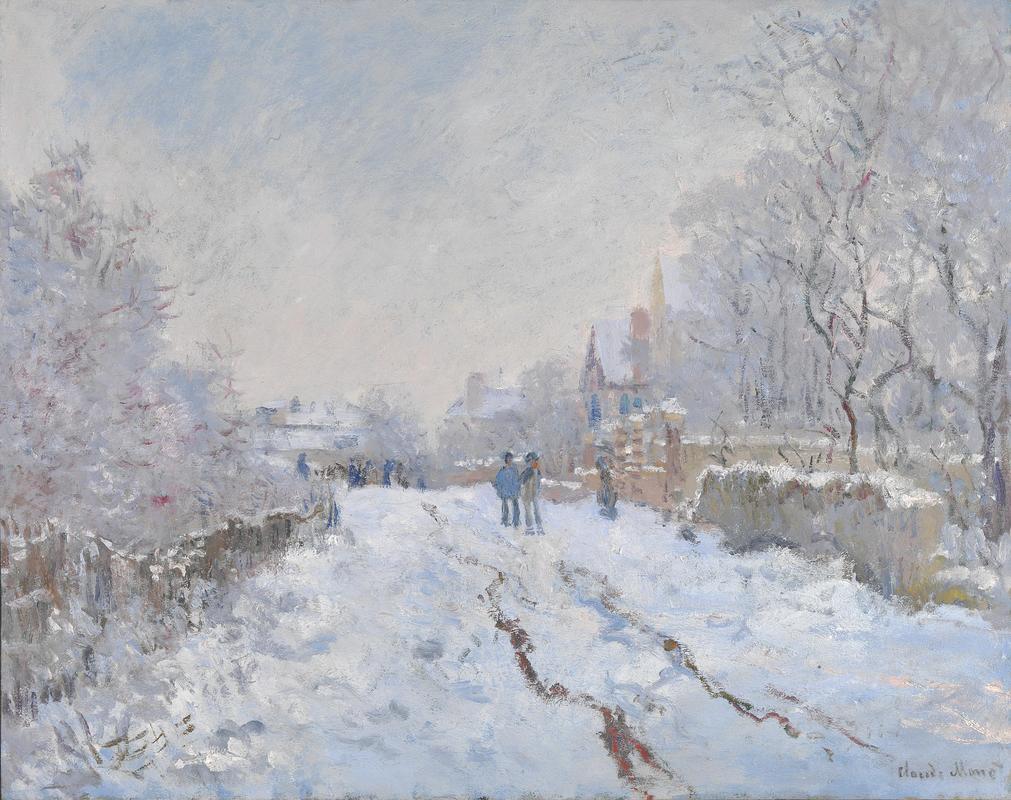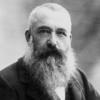More about Snow Scene at Argenteuil

Contributor
Claude Monet is probably most famous for his water lilies and his garden landscapes, which have captivated audiences for over a hundred years now.
Supposedly, he once proclaimed that he “must have flowers, always and always,” which is a fitting description of his artistic oeuvre. But before this flower period that reigned over the last decades of his life, when he was still young and foolish, he painted other stuff, and even in winter!
Snow at Argenteuil was painted shortly after his infamous Impression, Sunrise (1872). You know, the painting that made art critics go mad because he dared to produce a ‘rough and unfinished-looking’ painting. The audacity. But Monet was at the height of his youth, power, and ambition and he couldn’t care less about some rusty academics. This snow scene is an excellent representation of these early Impressionist endeavors.
There’s actually multiple versions of the same landscape from the winter between 1874 and 1875, because Monet was so fascinated by how the terrain looked covered in snow, how the light reflected off the snow, and how the sky changed color so quickly in winter.
Monet moved to Argenteuil, a Parisian suburb, after his voluntary exile to London to avoid the Franco-Prussian war. This particular view is from the train station, looking at the houses by the Seine. This street was just seconds away from Monet’s house and he painted here often. I guess he liked to watch the people come and go from the train station. In fact, the two faint figures in the center-right of the canvas seem to be making their way from the station, treading slowly through the thick snow.
The thickness of the snow is cleverly suggested by Monet with thick layers of white paint here and there to give the feeling of snow literally sitting on the canvas. Most of the canvas is filled with a vast, grayish sky. The grayness seems to suggest that it’s overcast, but there’s this slight pinkish hue pushing from behind the clouds, which points to a particular moment of the day — dusk.
But because it’s overcast and the pink sun rays are barely perceptible, Monet creates a totally different atmosphere to the usual pictures of sunsets that we are used to. And because it was such a delicate, quickly-changing mood, he had to paint quickly. Hence, the visible brushstrokes and the look of being ‘unfinished’. Monet understood that ain’t nobody got time to mix the colors perfectly when you only have seconds to capture the sun setting over the horizon, especially when your fingers are freezing off.
Monet’s dedication to paint en plein air (a fancy French term that means ‘outside’) was quite unique, even among the Impressionists. He wouldn’t just sketch out the rough composition or apply some base colors to then finish the painting in his studio. Instead, he painted the whole picture in one go, outside.
What was also different from the old way of academic art, and landscape painting in general, was that Monet used a light underpainting. This is the first layer of paint on top of which you paint the rest. He used white or light gray bases, instead of the typical black or dark brown washes, bringing more light into the paintings. And he didn’t use black at all. Rather, all the shadows were a mix of different dark colors. Because of this, the painting has a completely different feel — it’s light and breezy, the cold air is almost breathable.
In fact, he was so good at capturing the snowy atmosphere that, apparently, when Edouard Manet saw this winter landscape, he declared it was perfect and that he would never paint a snow scene after that.
Sources
- Auricchio, Laura. “Claude Monet (1840–1926).” in Heilbrunn Timeline of Art History. New York: The Metropolitan Museum of Art, 2000–. October 2004, URL = http://www.metmuseum.org/toah/hd/cmon/hd_cmon.htm. Accessed: 10th January 2022.
- Duret, Théodore. ‘L'Histoire de Édouard Manet et de son œuvre’. Le Plein Air. Librairie Charpentier et Fasquelle, 11 rue de Grenelle, Paris, 1906.
- Eisenman, Stephen F. et al., Nineteenth Century Art: A Critical History, London: Thames & Hudson Ltd., 3rd edition, 2007.
- The National Gallery Review of the Year. April 2007 – March 2008. Edited by Karen Morden and Rebecca McKie. London: The National Gallery, 2008.
Featured Content
Here is what Wikipedia says about Snow at Argenteuil
Snow at Argenteuil (French: Rue sous la neige, Argenteuil) is an oil-on-canvas landscape painting by the Impressionist artist Claude Monet. It is the largest of no fewer than eighteen works Monet painted of his home commune of Argenteuil while it was under a blanket of snow during the winter of 1874–1875. This painting—number 352 in Wildenstein's catalogue of the works of Monet—is the largest of the eighteen. The attention to detail evident in the smaller paintings is less evident in this larger picture. Instead, Monet has rendered large areas of the canvas in closely like tones and colours of blue and grey. The application of smaller strokes of greens, yellows, reds and darker blues breaks up these large expanses, and the almost choreographed dispersal of these various colours helps bind the picture together. Paint at the depicted road surface is thicker than elsewhere in the painting, and impasto is suggestive of the feel of disturbed snow.
Most of Monet's Snow at Argenteuil pictures from the winter of 1874–1875 were painted from locations close to the house on the boulevard Saint-Denis (now number 21 boulevard Karl Marx) into which Monet and his family had just moved. This particular painting shows the boulevard Saint-Denis looking in the direction of the junction with the rue de la Voie-des-Bans, with the river Seine out of sight to the rear, and the local railway station behind Monet's back as he painted.
In December 1879 the painting was acquired from Monet by Théodore Duret. Recalling a conversation with the artist Édouard Manet, Duret years later reported that, 'One winter he [Manet] wanted to paint a snow scene. I had in my possession just such a piece from Monet. After seeing it, he said "It is perfect! I would not know how to do better", whereupon he gave up painting snow.' The picture was acquired from Duret by the art dealers Boussod, Valadon et Cie of Paris in 1892; then by Harris Whittemore of Naugatuck, Connecticut in 1893. Acquavella Galleries of New York acquired the painting in the early 1970s, and then it was purchased by Simon Sainsbury in or around 1973. It was bequeathed by him to the National Gallery, London, in 2006 and it has remained there since.
Check out the full Wikipedia article about Snow at Argenteuil












